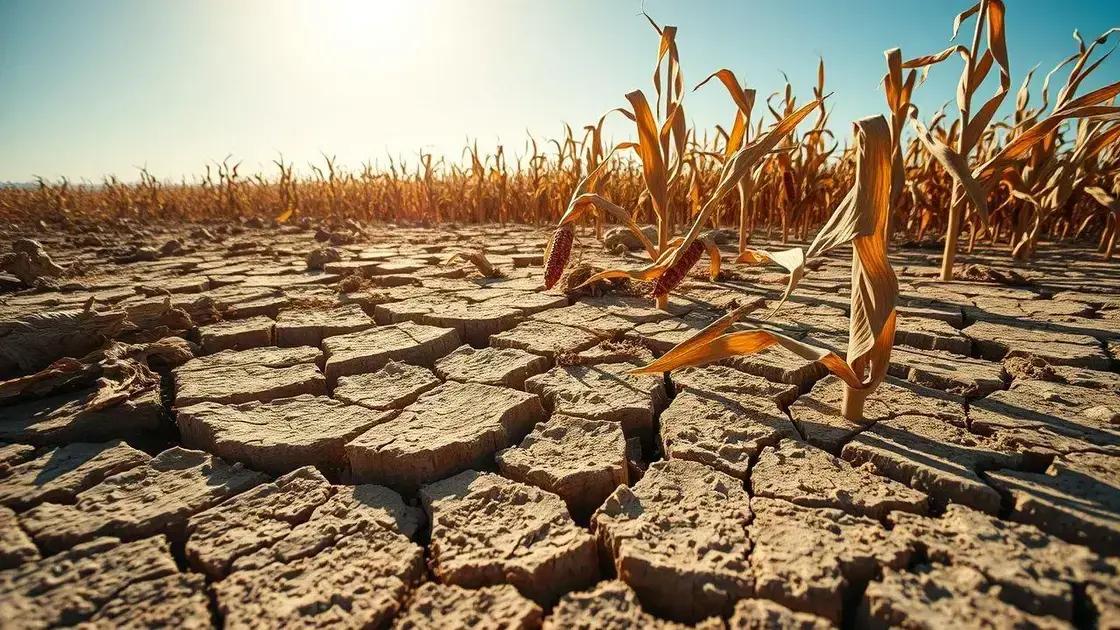Impact of droughts on U.S. agriculture exports

The impact of droughts on U.S. agriculture exports includes reduced crop yields, increased food prices, and economic challenges, necessitating effective strategies like efficient irrigation and drought-resistant crops to mitigate these effects.
The impact of droughts on U.S. agriculture exports is a pressing concern, influencing everything from prices to food security. Have you considered how these weather patterns affect what you find in stores?
Understanding droughts and their causes
Understanding droughts is crucial for comprehending their impact on agriculture. A drought occurs when there is a prolonged period of below-average precipitation, leading to water shortages. These conditions can significantly affect crop growth, altering food supply and prices.
The causes of droughts can vary widely. A few main factors include:
Natural Causes
Some droughts arise from natural occurrences. These include:
- Climatic changes
- Weather patterns such as El Niño
- Seasonal variability
These factors can lead to unpredictable rainfall, causing agricultural challenges.
Human Impact
However, human activity can also contribute to drought conditions. Over-extraction of water from rivers and lakes for irrigation can reduce available water supplies. Deforestation can lead to less rainfall and higher temperatures, creating a feedback loop that exacerbates drought.
Also, urbanization can change local weather patterns and increase temperatures, stressing water resources. Understanding these causes helps in developing strategies to mitigate the effects of drought on U.S. agriculture exports.
Effects of droughts on crop yields

The effects of droughts on crop yields are profound and can change the agricultural landscape significantly. When water becomes scarce, plants struggle to thrive. As a result, farmers face lower harvests and reduced income.
Several factors contribute to these effects:
Short-Term Impacts
In the short term, droughts impact crop yields immediately. Some effects include:
- Stunted growth of plants
- Decreased harvest sizes
- Lower quality of produce
These immediate challenges lead to reduced food supply in markets and increased prices for consumers.
Long-Term Consequences
Long-term, the situation can worsen. Extended periods of drought might lead to:
- Soil degradation
- Increased irrigation costs
- Loss of crop diversity
Farmers could face a future of poor soil health, making it harder to grow crops over time. This scenario threatens not only the farmer’s livelihood but also the food system as a whole.
Additionally, certain crops may fail completely, leading to significant economic losses. Farmers must adapt to these challenging conditions by changing crop selections or employing new agricultural techniques. Strategies such as drought-resistant seeds may help mitigate some adverse effects, but challenges will persist as climate change accelerates.
Economic impact on U.S. agriculture exports
The economic impact on U.S. agriculture exports during droughts is significant and multi-faceted. When drought conditions arise, the availability of key crops decreases, pushing market prices upward. This situation not only affects farmers but also consumers and the overall economy.
Many farmers face reduced crop yields, leading to lower export volumes. Crop prices can surge due to high demand and limited supply. The economic implications include:
Increased Prices
Consumers often bear the brunt of these changes, facing higher prices for food items. Some key impacts include:
- Higher costs of grains like corn and wheat
- Increased prices for meat and dairy products
- Inflationary pressures on household budgets
These price hikes can affect various sectors of the economy, leading to reduced purchasing power for consumers.
Global Trade Dynamics
The U.S. is a significant player in global agricultural markets. Droughts can shift trade dynamics as demand for imports rises from countries experiencing similar issues. Countries may seek to fill the gap by importing more from other nations, which can result in:
- Increased competition for U.S. crops
- Shifts in trade agreements and partnerships
- Potential trade deficits in agricultural sectors
As drought conditions persist, the economic landscape can shift dramatically. Farmers may turn to alternative crops, leading to longer-term changes in U.S. agricultural exports. Understanding these economic impacts is essential for policymakers and stakeholders in the agriculture sector.
Strategies for mitigating drought effects

Strategies for mitigating drought effects are essential for preserving both agricultural sustainability and economic stability. Farmers and policymakers must adopt practices that enhance resilience in the face of these challenging conditions. Effective strategies can help safeguard crop yields, ensuring food security.
Implementing water conservation techniques is one of the key strategies. These practices can include:
Efficient Irrigation Systems
Using advanced irrigation methods can greatly reduce water wastage. Techniques such as:
- Drip irrigation
- Soil moisture sensors
- Rainwater harvesting
These tools enable farmers to deliver precise amounts of water directly to the roots, maximizing crop health while minimizing runoff.
Crop Management Practices
In addition to efficient irrigation, selecting appropriate crops plays a vital role in drought resilience. Farmers can consider:
- Switching to drought-resistant varieties
- Rotating crops to improve soil health
- Using cover crops to retain moisture
These practices not only help in maintaining yields but also improve overall soil quality, which is crucial during dry spells.
Lastly, investing in technology can provide valuable insights and data. Weather forecasting tools and agricultural apps help farmers make informed decisions. By leveraging technology, farmers can adapt quickly to changing conditions, ensuring better preparedness for future droughts. Combining these strategies can create a robust framework for managing drought impacts, ultimately supporting U.S. agriculture.
FAQ – Frequently Asked Questions about Drought Effects on U.S. Agriculture
What are the main effects of droughts on crop yields?
Droughts lead to reduced crop yields due to water shortages, resulting in stunted plant growth, lower harvest sizes, and decreased quality of produce.
How do droughts impact food prices?
As crop yields decline during droughts, the supply of food decreases, which usually causes food prices to rise, affecting consumers and the economy.
What strategies can farmers use to mitigate drought effects?
Farmers can adopt efficient irrigation systems, use drought-resistant crop varieties, and implement crop rotation and other sustainable practices.
How does technology help in managing drought impacts?
Technology, such as soil moisture sensors and weather forecasting tools, helps farmers make informed decisions, optimizing water use and improving crop management during droughts.





